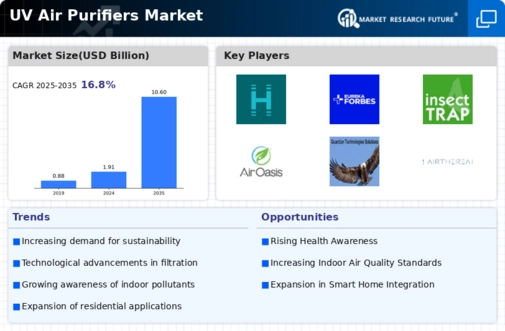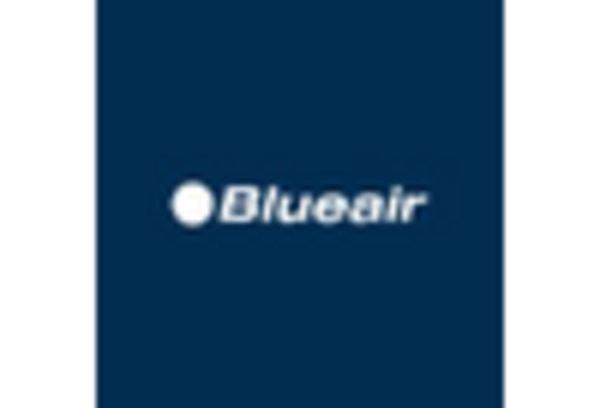Technological Innovations
Technological advancements play a crucial role in shaping the UV Air Purifiers Market. Innovations in UV-C light technology have enhanced the efficiency and effectiveness of air purifiers. Newer models are equipped with smart features, such as real-time air quality monitoring and automated operation, which appeal to tech-savvy consumers. The integration of IoT capabilities allows users to control devices remotely, further driving market growth. According to recent data, the introduction of advanced filtration systems in UV air purifiers has led to a significant increase in their adoption rates. As manufacturers continue to invest in research and development, the market is expected to witness a surge in innovative products that cater to diverse consumer needs.
Rising Air Quality Concerns
The increasing awareness regarding air quality issues is a primary driver for the UV Air Purifiers Market. As urbanization continues to rise, many regions experience deteriorating air quality, leading to health complications. Reports indicate that air pollution contributes to millions of premature deaths annually, prompting consumers to seek effective solutions. UV air purifiers, known for their ability to eliminate airborne pathogens and pollutants, are gaining traction. The market is projected to grow as individuals and businesses prioritize clean air environments, with a notable increase in demand for residential and commercial air purification systems. This trend is likely to continue as more people recognize the importance of maintaining healthy indoor air quality.
Regulatory Support and Standards
Regulatory frameworks and standards are increasingly influencing the UV Air Purifiers Market. Governments and health organizations are establishing guidelines to improve indoor air quality, which encourages the adoption of air purification technologies. For instance, certain regions have implemented regulations that mandate the use of air purifiers in public spaces, thereby boosting market demand. Additionally, certifications from recognized bodies enhance consumer trust in UV air purifiers, making them more appealing. The market is likely to benefit from ongoing regulatory support, as it aligns with public health initiatives aimed at reducing airborne diseases and improving overall well-being. This trend suggests a favorable environment for market expansion.
Growing Awareness of Indoor Pollution Sources
The growing awareness of indoor pollution sources is a significant driver for the UV Air Purifiers Market. Many consumers are becoming increasingly informed about the various pollutants present in their homes, such as dust, mold, and volatile organic compounds. This awareness is prompting individuals to seek effective solutions to mitigate these risks. UV air purifiers are recognized for their ability to neutralize harmful microorganisms and improve overall air quality. As educational campaigns and information dissemination continue to rise, the market is expected to expand, with more consumers opting for air purification systems to create healthier living spaces. This trend indicates a shift towards proactive health management in residential and commercial settings.
Increased Consumer Spending on Health Products
The trend of increased consumer spending on health-related products significantly impacts the UV Air Purifiers Market. As individuals become more health-conscious, they are willing to invest in products that promote well-being, including air purifiers. Market data indicates that the health and wellness sector has seen substantial growth, with consumers prioritizing products that enhance their living environments. This shift in consumer behavior is likely to drive demand for UV air purifiers, as they are perceived as essential tools for maintaining a healthy indoor atmosphere. The willingness to spend on premium air purification solutions suggests a robust market potential, particularly among affluent consumers seeking high-quality products.
















Leave a Comment